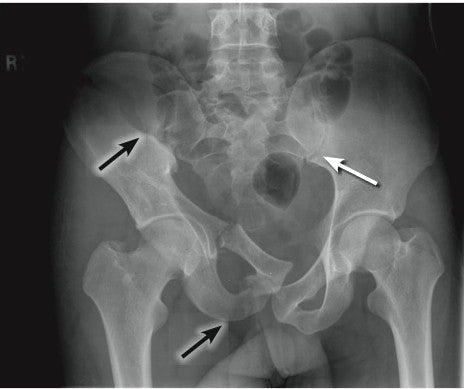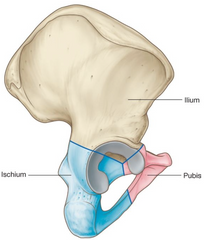Ask a Pro: Pelvic Instability and Emergency Treatment

 The back bone’s connected to the hip bone, the hip bone’s connected to the leg bone, the leg bone…
The back bone’s connected to the hip bone, the hip bone’s connected to the leg bone, the leg bone…
The hip bone? True, in every day speech it’s not uncommon to hear of someone breaking their “hip.” But this hip bone is actually a lot more complex than first meets the eye. As the title suggests, this blog post is going to look at trauma to the pelvis. To keep from getting overwhelmed in detail, this post will greatly simplify a lot of the complex anatomy. If you are interested in reading further, I’ve written a separate article which covers some of these components in more detail.
The pieces
To start this discussion it’s important to have a good understanding of the anatomy and layout involved.
 Ok, bad news first: there’s a lot (and I mean a LOT) of pieces here. The good news is we can simplify a lot of it down.
Ok, bad news first: there’s a lot (and I mean a LOT) of pieces here. The good news is we can simplify a lot of it down.
The pelvis is composed of 4 different sections: (1) the bony pelvis, (2) the pelvic cavity, (3) the pelvic floor, and (4) the perineum. Complicating things is a whole series of nerves and blood vessels running throughout the region. But don’t worry, I’ll walk you through the whole system below. Piece of cake, right?
Bony Pelvis

 Let’s start by talking bones. The pelvis is made up of your left and right hip (pelvic) bones, as well as the Sacrum and Coccyx of your spine. The left and right Pelvic bones are often called the Pelvic Girdle and form what we classically think of as our hips. Each hip bone is actually comprised of 3 separate bones, sometimes called innominate bones, which are tightly joined together: the Ilium, Ischium, and Pubis. Together these bones also make up the Acetabulum, or socket, which connects your femur, or leg bone. Now I know that sounds like a bunch of Latin rubbish, which it is, but the important part is really quite simple.
Let’s start by talking bones. The pelvis is made up of your left and right hip (pelvic) bones, as well as the Sacrum and Coccyx of your spine. The left and right Pelvic bones are often called the Pelvic Girdle and form what we classically think of as our hips. Each hip bone is actually comprised of 3 separate bones, sometimes called innominate bones, which are tightly joined together: the Ilium, Ischium, and Pubis. Together these bones also make up the Acetabulum, or socket, which connects your femur, or leg bone. Now I know that sounds like a bunch of Latin rubbish, which it is, but the important part is really quite simple.
.
The primary function of the pelvic bones is to support the connection between your spine and your legs.
 The pictures above and to the right should give you a good visual for these bones. One thing that you’ll notice is that these bones form one large boney ring, and two smaller, lower boney rings. While it might not seem like a stroke of genius, this is actually a crucial point when talking about fractures and trauma. When subjected to severe forces, these boney circles tend to break in not one, but two locations. This predilection to multiply break sites is one of the aggravating factors in pelvic trauma. We’ll talk more about this later, but keep it in mind.
The pictures above and to the right should give you a good visual for these bones. One thing that you’ll notice is that these bones form one large boney ring, and two smaller, lower boney rings. While it might not seem like a stroke of genius, this is actually a crucial point when talking about fractures and trauma. When subjected to severe forces, these boney circles tend to break in not one, but two locations. This predilection to multiply break sites is one of the aggravating factors in pelvic trauma. We’ll talk more about this later, but keep it in mind.
Pelvic Cavity
 This part is exactly like the name suggests: the space in between all these bones in the pelvis. It’s probably no surprise that several of your internal organs call this area home, notably the rectum, bladder, and in women, the uterus and ovaries. Take a look at the image on the left, and you’ll note that the Pelvic Cavity, or True Pelvis, is the space located below the red line. For our purposes it’s enough to know this cavity exists and is continuous with the abdomen, holding some internal organs.
This part is exactly like the name suggests: the space in between all these bones in the pelvis. It’s probably no surprise that several of your internal organs call this area home, notably the rectum, bladder, and in women, the uterus and ovaries. Take a look at the image on the left, and you’ll note that the Pelvic Cavity, or True Pelvis, is the space located below the red line. For our purposes it’s enough to know this cavity exists and is continuous with the abdomen, holding some internal organs.
As a matter of interest, this drawing also shows the pelvis in proper anatomical position, as if you were standing up straight.
Pelvic Floor
 As you’ve probably guessed, the Pelvic Floor is that part which closes off the bottom of the Pelvic Cavity. Without it you would find yourself constantly picking your intestines up off the ground. Think of the pelvic floor as forming a bowl at the bottom of the pelvic bones, made of muscles and ligaments, and helping to hold everything in place. This picture on the right gives a good overview of the muscles and the image below highlights the important ligaments. I’ll skip most of the details but want to point out two very important ligaments in the area.
As you’ve probably guessed, the Pelvic Floor is that part which closes off the bottom of the Pelvic Cavity. Without it you would find yourself constantly picking your intestines up off the ground. Think of the pelvic floor as forming a bowl at the bottom of the pelvic bones, made of muscles and ligaments, and helping to hold everything in place. This picture on the right gives a good overview of the muscles and the image below highlights the important ligaments. I’ll skip most of the details but want to point out two very important ligaments in the area.  The Sacrospinous Ligament and the Sacrotuberous Ligament each connect from the Sacrum to different parts of the Ischium bone. These ligaments create some very important structures, or rather openings in the pelvis. Take a look at the picture on the left. You’ll notice the spaces above and below these ligaments, the Greater and Lesser Sciatic Foramina. Foramen is a fancy word for opening, but these openings allow some extremely important nerves and blood vessels to pass through.
The Sacrospinous Ligament and the Sacrotuberous Ligament each connect from the Sacrum to different parts of the Ischium bone. These ligaments create some very important structures, or rather openings in the pelvis. Take a look at the picture on the left. You’ll notice the spaces above and below these ligaments, the Greater and Lesser Sciatic Foramina. Foramen is a fancy word for opening, but these openings allow some extremely important nerves and blood vessels to pass through.  As you can see in this drawing, they’re also crucially important in supporting the weight of your upper body. The Greater and Lesser Sciatic Foramina are referred to as Fibro-Osseous rings, meaning they are rings made up of part fibrous tissue (ligaments) and part bone. You’ll also remember in the Bony Pelvis section we talked about the 3 boney rings and they’re importance in fractures. Similarly we have 4 Fibro-Osseous rings, the left and right Greater and Lesser Sciatic Foramina.
As you can see in this drawing, they’re also crucially important in supporting the weight of your upper body. The Greater and Lesser Sciatic Foramina are referred to as Fibro-Osseous rings, meaning they are rings made up of part fibrous tissue (ligaments) and part bone. You’ll also remember in the Bony Pelvis section we talked about the 3 boney rings and they’re importance in fractures. Similarly we have 4 Fibro-Osseous rings, the left and right Greater and Lesser Sciatic Foramina.
Perineum
Below the Pelvic Floor is a small region called the Perineum. The Perineum contains three parts:
- the terminal openings of the gastrointestinal and urinary tracts,
- the external opening of the reproductive tract, and
- the roots of the external genitalia.
While distinguishing between these two regions is not crucial for first responders and rescuers operating in the field, I do want you to be aware that it exists. Damage to the Perineum is not typically life threatening, but in severe trauma, the damage is often permanent and can lead to serious long-term complications and morbidity for the patient, specifically with regards to bladder, bowel, and sexual function.
Vasculature
 As you might guess, in order for blood coming from your heart to reach your legs, it has to pass by or through the pelvic region. Not surprisingly, there’s a lot of blood and blood vessels.
As you might guess, in order for blood coming from your heart to reach your legs, it has to pass by or through the pelvic region. Not surprisingly, there’s a lot of blood and blood vessels.
By far the most important blood vessels in the area are the Iliac arteries and veins. While the Internal Iliac artery and vein supply the components in the pelvic cavity, the External Iliac artery and vein pass by, in front of the pelvic bones, and become the Femoral artery and vein. Not surprisingly, pelvic trauma can result in any of these arteries, veins or their branches being severed. This can compromise blood flow to the lower limbs or pelvic structures, and can also be severe enough to induce hypovolemic shock and even death. This diagram gives a good overview.
Nerve Supply
 Much like the vascular supply, the nervous system running to and through the pelvic region is substantial and complex. The photo to the left and below show some of the complexity involved, and while it’s not necessary to know each nerve, it’s important to grasp the quantity of nerves involved. Just as the vasculature can be severed or damaged in pelvic trauma, so too can any of the nerves.
Much like the vascular supply, the nervous system running to and through the pelvic region is substantial and complex. The photo to the left and below show some of the complexity involved, and while it’s not necessary to know each nerve, it’s important to grasp the quantity of nerves involved. Just as the vasculature can be severed or damaged in pelvic trauma, so too can any of the nerves. 
While damage is unlikely to result in death, it is almost always permanent and greatly increases morbidity. Further complicating the issue is the risk of broken pelvic bones severing nearby nerves if the patient is moved improperly. The result can be loss of sensation, motor control, or function to the lower limbs, reproductive organs, bladder, or bowel.
Epidemiology
Pelvic fractures are, thankfully, a small percentage of all skeletal fractures; approximately 3%.(1) However, because of the important anatomy in the pelvis, and the mechanisms that tend to cause these injuries, pelvic trauma is not something to take lightly. Mortality ranges from 5-16% of all pelvic fractures, and in unstable cases, mortality is around 8%.(2) Unfortunately, patients who present with open fractures are at serious risk with mortality rates up to 45%!(3)
 Not surprisingly, different mechanisms of injury are more or less likely to cause pelvic fractures. Pelvic fractures are also classified into different categories. We’ll talk about these categories in more detail shortly, but they are: pelvic ring disruptions, sacral fractures, acetabular fractures, and avulsion fractures. Motor vehicle and motorcycle accidents are by far the most common cause of pelvic fractures given the high-energy forces involved and represent up to 58% of all causes.(4) Pedestrians struck by vehicles account for another 22%, and falls and other causes round out the rest.(4) The story is similar for acetabular fractures, although motor vehicle accidents are responsible for an even greater number of cases, upwards of 83%.(5) Falls represent a fairly small portion of the total number of pelvic trauma injuries, however if you consider age as a factor, you’ll see that it’s almost exclusively an infirmity of the elderly.(4)
Not surprisingly, different mechanisms of injury are more or less likely to cause pelvic fractures. Pelvic fractures are also classified into different categories. We’ll talk about these categories in more detail shortly, but they are: pelvic ring disruptions, sacral fractures, acetabular fractures, and avulsion fractures. Motor vehicle and motorcycle accidents are by far the most common cause of pelvic fractures given the high-energy forces involved and represent up to 58% of all causes.(4) Pedestrians struck by vehicles account for another 22%, and falls and other causes round out the rest.(4) The story is similar for acetabular fractures, although motor vehicle accidents are responsible for an even greater number of cases, upwards of 83%.(5) Falls represent a fairly small portion of the total number of pelvic trauma injuries, however if you consider age as a factor, you’ll see that it’s almost exclusively an infirmity of the elderly.(4)
 As catastrophic as these high-energy collisions can be to the pelvis, it’s generally not the pelvic fracture itself that causes major complications. Generally, a number of other internal structures are injured which lead to the severe disability or death.(6) Hemorrhage is by far the biggest concern. One study found that 38.5% of pelvis injury patients in hospital required blood transfusions,(7) with venous bleeding being the cause in 80-90% of cases.(8) Intra-abdominal injuries occur in another 16.5% of high-energy pelvic trauma patients and involve organs like the spleen, liver, and bowel. Interestingly, the bladder and urethra are not injured as frequently; only about 3.5% of cases.(9) However, neurological impairment is a not insignificant source of complications occurring in 10-15% of patients, and up to 50% in severe sacral fractures.(10)
As catastrophic as these high-energy collisions can be to the pelvis, it’s generally not the pelvic fracture itself that causes major complications. Generally, a number of other internal structures are injured which lead to the severe disability or death.(6) Hemorrhage is by far the biggest concern. One study found that 38.5% of pelvis injury patients in hospital required blood transfusions,(7) with venous bleeding being the cause in 80-90% of cases.(8) Intra-abdominal injuries occur in another 16.5% of high-energy pelvic trauma patients and involve organs like the spleen, liver, and bowel. Interestingly, the bladder and urethra are not injured as frequently; only about 3.5% of cases.(9) However, neurological impairment is a not insignificant source of complications occurring in 10-15% of patients, and up to 50% in severe sacral fractures.(10)
Pelvic Fracture Classifications
As mentioned above, pelvic fractures are grouped into different categories: Pelvic Ring Disruption, Sacral Fractures, Acetabular Fractures, and Avulsion Fractures. While these can be of utmost importance in determining hospital care and management strategies, they are less significant for rescuers and pre-hospital care. We simply don’t have X-ray, Ultrasound, or CT capabilities at the scene of an incident. However, understanding the different categories gives us a better appreciation of what types of injuries we might be dealing with, even if we can’t definitively classify them on scene.
Pelvic Ring Disruption
This is an important concept, and something we hinted at earlier in the blog. Because the pelvic bones form a ring, a break in one part of the ring is likely to cause a second break somewhere else. Again, does this change our management in the field? Not really, but it’s important to remember how and why these injuries can be so serious. Different classification systems exist, but one commonly used is the Young-Burgess. The following table and picture outline the different groups.
|
Lateral Compression Injuries |
Type 1 |
Sacral fracture on same side as impact. Most common. |
|
Type 2 |
Crescent fracture on same side as impact. |
|
|
Type 3 |
Type 1 or 2 fracture with a contralateral fracture (open book) |
|
|
Anterioposterior Compression Injuries |
Type 1 |
Minor opening of pubic symphysis and sacroiliac joint |
|
Type 2 |
Opening of pubic symphysis and anterior SI joint, but intact posterior SI joint |
|
|
Type 3 |
Complete opening of pubic symphysis, anterior and posterior SI joint |
|
|
Vertical Shear Injuries |
|
Vertical displacement of hemipelvis |
|
Combined |
|
Any combinations of the above |

Sacral Fractures

|
Zone 1 |
Lateral to the sacral foramina |
|
Zone 2 |
Through the sacral foramina |
|
Zone 3 |
Medial to the sacral foramina |
Acetabular Fractures
Letournel and Judet created a commonly used classification system for acetabular fractures. The 5 listed in this drawing are not exhaustive, but give a general understanding to this system.

Avulsion Fracture
While not impossible, this type of fracture is not generally associated with high-energy trauma. Rather, it’s often seen in skeletally immature athletes and results from sudden forceful muscle contractions, which cause part of the boney pelvis to break away.
Signs & Symptoms
History, Mechanism of Injury, and Pain are by far the biggest clues for rescuers and first responders. While they don’t guarantee that a fracture has occurred, there presence should be taken as strongly suggestive. This is amplified when combined with a host of other potential symptoms outlined below. Do remember that patients may not be conscious or sufficiently coherent to provide more detailed information about pain or neurological deficits. As such, responders must be vigilant and maintain a high degree of suspicion for pelvic instability whenever history or symptoms suggest.
Muskuloskeletal
Given the fractures to the bone, it follows that some MSK symptoms may be evident to responders. Keep a watchful eye for any of the following: (11, 12, 13)
- Open fractures
- Deformities or malrotation
- Impaired or painful movements
- Leg length discrepancies
- Asymmetrical boney landmarks (ex: Greater Trocanter, ASIS)
One challenging issue is the use of compression or “springing” to assess for pelvic fractures. This is where the health care provider uses their palms to gently compress the pelvis inwards or downwards to assess for instability. This is a delicate topic and it’s important to note that different professionals have different views on its importance and usefulness. I must stress that this article in no way constitutes medical advice and you should follow your local guidelines and work within your training. I do, however, want to provide you with the most current, science-based information available.
While springing may be required in certain cases, a crucial study by Grant published in 1990 found that springing was a poor predictor of pelvic fractures with a specificity of 71% and a sensitivity of only 59%(14). The concern lies in the risk that this manoeuvre may dislodge blood clots which are helping to limit bleeding or may further damage internal tissues by unnecessarily moving the broken boney fragments. Because of these concerns and the Grant study, many are recommending that health care providers avoid springing altogether.(15, 16, 18) That being said, the practice is still used and recommended by some. The ATLS, published by the American College of Surgeons still recommends that it be performed as part of the hospital assessment,(17) while others recommend it’s use but caution its usefulness without adequate training.(19)
Vascular
Injury to the arteries and veins in the pelvis is extremely common and a serious complication. As noted earlier, the greatest source of mortality from pelvic fractures arises from uncontrolled haemorrhage, specifically venous bleeding. As such, responders need to be on the lookout for tell-tale signs of vascular compromise.
- Echymosis
- Open wounds
- Hematuria, vaginal or rectal bleeding
- Lack of femoral or pedal pulses
- Hemodynamic instability
Hemodynamic instability is an extremely important sign in pelvic fractures. While any traumatic event can cause a patient to go into shock, significant blood loss from internal bleeding can cause a precipitous drop in blood pressure. Pulse rates of >100 bpm or a systolic blood pressure of <90 mmHg should be a warning sign of potential hypovolemic instability.(20) Increasing pulse and respiratory rates, diminishing mental status, as well as increasing anxiety, disorientation, or confusion should also raise alarm bells.(11)
Neurologic
Nerve damage is another consideration in pelvic trauma and can present with a range of symptoms:
- Numbness and tingling
- Parasthesia
- Impaired movement/strength or paralysis
- Bladder and bowel incontinence
While neurologic deficits are less likely to be immediately fatal, they may be irreversible and can significantly contribute to the morbidity of pelvic trauma.
Treatment
**This article in no way constitutes medical advice and should not be considered as such. You should refer to your local guidelines and work within your training parameters.**
The majority of the treatment and management offered to patients suffering from pelvic trauma is undoubtedly provided in hospital settings. However, there are still several key elements of care that first responders and rescuers can provide which greatly improve outcomes.
Prompt assessment, triage, and transport
It goes without saying that a quick response can make a huge difference. While many factors, like travel time, are out of the first responder’s control, others, like awareness of pelvic fractures, assessment, and triage can be advanced. In these regards, proper training and simulation are invaluable.
Careful transport
One manoeuver often employed for transport is the log roll. Unfortunately, patients with pelvic fractures are at increased risk of further complication when this procedure is performed. Similar to the concern around springing, log rolling has the potential to dislodge existing blood clots or exacerbate internal injuries. Because of this, many recommend avoiding this practice.(15, 20) Practically speaking, this may not always be possible, especially in the field, when personnel are limited, or in life-over-limb situations. Some do recommend a log roll as part of a primary or secondary survey but caution its use and note that a proper risk-benefit evaluation should be undertaken.(16) Partial log rolls of 10-15 degrees or scoop stretchers, if available, may provide better options for first responders.
Pelvic Binding
This procedure was initially done using sheets but was found to be so effective that many commercial pelvic binders now exist.(15) The rationale behind the technique is two-fold. Firstly, the binding helps stabilize the pelvis. This protects the internal structures from further damage and aggravation by sharp, boney fragments. Importantly it also prevents blood clots from being dislodged, and has been found to aid in pain relief.(21) Secondly, pelvic binders help reduce boney bleeding by bringing the fracture ends closer together.(15) Some people have also suggested that binding decreases the volume of the true pelvic cavity. This would limit the amount of blood that can fill the space and therefore assists by creating a tamponade, or compressive back-pressure, on the leaking blood vessels to prevent further loss. However, the increase in volume of the true pelvis is actually quite small, and researchers doubt that reduction of the volume will create this tamponade effect.(15,22)
Regardless of the exact mechanism, pelvic binding is one of the few field techniques that consistently improve outcomes.(11, 12, 13, 15, 16, 19, 20) As always, appropriate training is crucial, but prompt and proper application of pelvic binders is hugely beneficial to the patient. One type of pelvic binder is the SAM Pelvic Sling II. The SAM Pelvic Sling II has some of the strongest evidence supporting its use while also reducing the risk of overcompression.(20, 23) You can check it out here.
As always, stay safe
- The Dynamic Rescue Team
References
- Grotz MR, Allami MK, Harwood P, Pape HC, Krettek C, Giannoudis PV. “Open pelvic fractures: epidemiology, current concepts of management and outcome.“ Injury. 36.1 (2005): 1. Web.
- Yoshihara H, Yoneoka D. “Demographic epidemiology of unstable pelvic fracture in the United States from 2000 to 2009: trends and in-hospital mortality.” Journal of Trauma and Acute Care Surgery. 76.2 (2014): 380. Web.
- Dente CJ, Feliciano DV, Rozycki GS, Wyrzykowski AD, Nicholas JM, Salomone JP, Ingram WL. “The outcome of open pelvic fractures in the modern era.” American Journal of Surgery. 190.6 (2005): 830. Web.
- Balogh Z, King KL, Mackay P, McDougall D, Mackenzie S, Evans JA, Lyons T, Deane SA. “The epidemiology of pelvic ring fractures: a population-based study.” Journal of Trauma. 63.5 (2007): 1066. Web.
- Porter SE, Schroeder AC, Dzugan SS, Graves ML, Zhang L, Russell GV. “Acetabular fracture patterns and their associated injuries.” Journal of Orthopedic Trauma. 22.3 (2008): 165. Web.
- Hauschild O, Strohm PC, Culemann U, Pohlemann T, Suedkamp NP, Koestler W, Schmal H. “Mortality in patients with pelvic fractures: results from the German pelvic injury register.” Journal of Trauma. 64.2 (2008): 449. Web.
- Demetriades D, Karaiskakis M, Toutouzas K, Alo K, Velmahos G, Chan L. “Pelvic fractures: epidemiology and predictors of associated abdominal injuries and outcomes.” Journal of American College of Surgeons. 195.1 (2002): 1. Web.
- Gänsslen A, Giannoudis P, Pape HC. “Hemorrhage in pelvic fracture: who needs angiography?” Current Opinion in Critical Care. 9.6 (2003): 515. Web.
- Bjurlin MA, Fantus RJ, Mellett MM, Goble SM. “Genitourinary injuries in pelvic fracture morbidity and mortality using the National Trauma Data Bank.” Journal of Trauma. 67.5 (2009): 1033-9. Web.
- Denis F, Davis S, Comfort T. “Sacral fractures: an important problem. Retrospective analysis of 236 cases.” Clinical Orthopedic Related Research. 227 (1988): 67. Web.
- Friese G, Lamay G. “Emergency Stabilization of Unstable Pelvic Fractures.” http://www.emsworld.com/article/10323983/emergency-stabilization-of-unstable-pelvic-fractures. May 1, 2005.
- Nickson C. “Trauma! Pelvic Fractures I.” http://lifeinthefastlane.com/trauma-tribulation-027/. May 1, 2005.
- Fiechtl J, Moreira M, Bachur R, Grayzel J. “Pelvic Trauma: Initial Evaluation and Management.” http://www.uptodate.com/contents/pelvic-trauma-initial-evaluation-and-management . Mar 24, 2015.
- Grant P. “The Diagnosis of Pelvic Fractures by ‘Springing.’” Archives of Emergency Medicine. 7.3 (1990): 178-82. Web.
- Lee C, Porter K. “The prehospital management of pelvic fractures.” Emergency Medicine Journal. 24.2 (2007): 130–133. Web.
- Little G, Kelly M, Glucksman E. “Critical pitfalls in the immediate assessment of the trauma patient.” Trauma. 3 (2001): 43–51. Web.
- American College of Surgeons, Committee on Trauma. ATLS Advanced Trauma Life Support for Doctors. 8th Ed. United States, 2008.
- Yong E, Vasireddy A, Pavitt A, Davies G, Lockey D. “Pre-hospital pelvic girdle injury: Improving diagnostic accuracy in a physician-led trauma service.” Injury - International Journal of the Care of the Injured. 47 (2016): 383-388. Web.
- Heetveld, Martin. The Management of Haemodynamically Unstable Patients with a Pelvic Fracture. NSW Institute of Trauma and Injury Management, 2007. Web.
- Scott I, Porter K, Laird C, Greaves I, Bloch M. “The pre-hospital management of pelvic fractures: initial consensus statement.” Journal of Paramedic Practice. 6.5 (2014): 248-252. Web.
- Krieg J, Mohr M, Ellis R, Simpson R, Madey S, Bottlang M. “Emergent stabilization of pelvic ring injuries by controlled circumferential compression: a clinical trial.” Journal of Trauma. 59.3 (2005): 659-664. Web.
- Grimm M R, Vrahas M S, Thomas K A. “Pressure‐volume characteristics of the intact and disrupted pelvic retroperitoneum.” Journal of Trauma. 44.3 (1998): 454–459. Web.
- Bottlang M, Krieg J C, Mohr M. et al. “Emergent management of pelvic ring fractures with use of circumferential compression.” Journal of Bone and Joint Surgery. 84‐A.Suppl 2 (2002): 43–47. Web.
Also in Blog

Check This Out - Freakin' Beacon
The "Freakin' Beacon"
User feedback was the driving force behind this design, Koehler BrightStar tells us, and it was important to have a product that was lightweight, durable and bright.
Weighing in at just 97 grams (yes, that includes 2x AAA batteries) and less than 7cm long, this unit is amazingly powerful for its small size.

RECOMMENDATIONS FOR DISINFECTING YOUR EQUIPMENT - Petzl
During the current COVID-19 crisis, many of you have sent us questions on how to disinfect your equipment. Here are the basics that you need to know.


